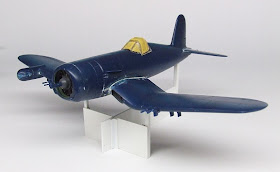
They do say there’s a finite lifespan to decals, and anyone who has opened a vintage kit can attest to how fragile, faded and yellowed they can become. But decal technology has come a long way and when firms like Microscale came along they used only the best. I have had aftermarket decals perish, but not the good stuff.
The latest milestone on the Italeri Corsair was getting the markings on. I had meant to do Guy Bordelon’s plane but Italeri got the famous blue (substituting for white to ‘tone down’ the visibility for a nightfighter unit during the Korean war) too vivid. I have Superscale’s better version but before I was able to locate them I decided to go with the standard marking option in the kit, VMF(N)-513. I had applied Microscale Satin over the Tamiya XF-17 paintwork, resulting in a nice, smooth lustre, and I began on the underside for caution’s sake. The kit decals were very thin, very fragile, and the whites were translucent… Not the best, but there are always options.
Out came the big box which stores decals, most of them Superscale. The “Marines” title under the wing was sourced from sheet 72-20, and the non-backgrounded national insignia, with their separately printed red bars, from 72-12. These days, the range is way above a thousand sheets and still counting, and it must be over a decade since Krasel Industries announced they would no longer be reprinting their old releases. These two sheets date from the early 1970s and may have been printed no later than the mid-90s, so I had to wonder at first how they might perform.
They have been stored away from light and pressed firmly in their packets away from air, reasonably cool and always completely dry, and these conditions seem to be acceptable, because they worked fine. Superscales are incredibly thin and that makes them inherently fragile, these tore two or three times, but were coaxed into place with the standard Microscale system chemistry. The model was given a careful wash with a brush dipped in clean water and swabbed with a tissue to remove dried chemistry, which will otherwise show up instantly and indelibly as dull tidemarks under clear coats, then another coat of satin was applied to seal everything up.
Keep a thing twenty years and you’ll find a use, they say, and these decals replaced the kit items perfectly, reducing the somewhat translucent items to codes and serials. They do look slightly different, but not so much the casual glance would pick up the problem.
I’m glad these decals work so well after such a long time ‘on standby,’ as it were. My decal collection is considerable and I look forward to finally having the chance to use it properly, building many colourful and spectacular subjects in future.










